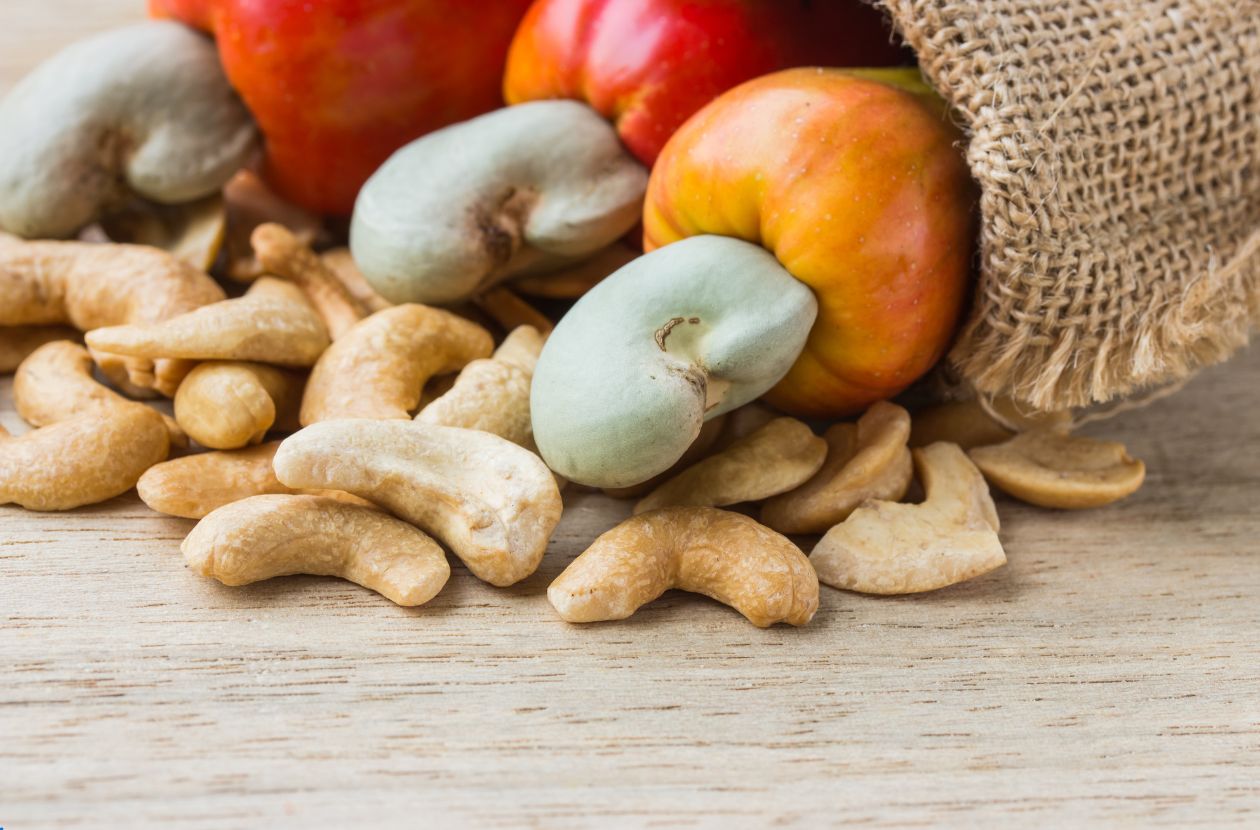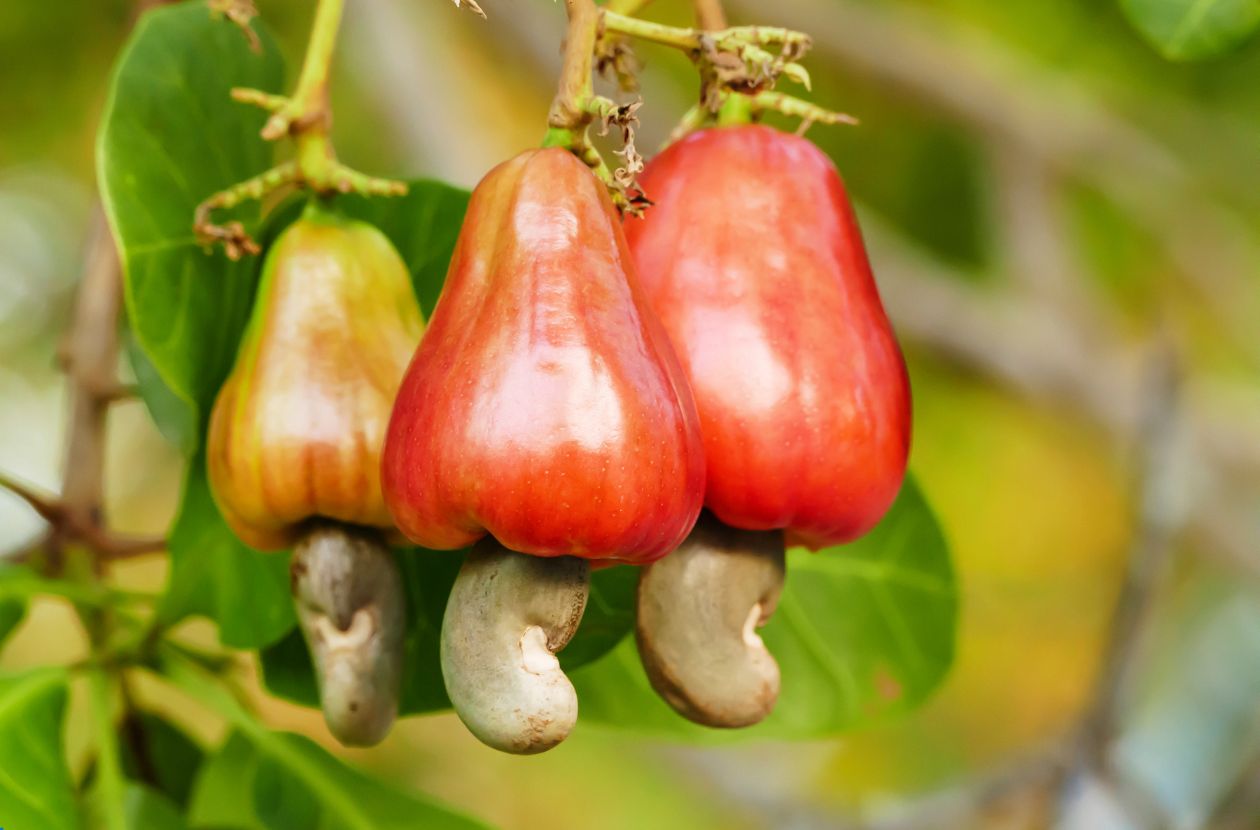Contents
You know what a cashew is. Those crunchy bites they put in your trail mix. But did you know that cashews don’t grow underground like peanuts or inside shells like walnuts? They grow on the bottom of a weird, colorful fruit.
Enter the marañón fruit. It’s bright, juicy, and looks like a mix between a bell pepper and an apple…with a claw coming out of it. When I saw it at a fruit market in Costa Rica for the first time, I honestly thought it was fake. It looked unreal.
But that’s why it’s so great.
Marañón Fruit — Cashews Grow on a Fruit?
Yes. Cashews grow on a fruit. A fruit you probably never knew existed.
The marañón fruit (aka cashew apple) is native to Central America and is the fleshy pear-shaped part of the plant that grows above the cashew nut. The nut/seed (it is technically a seed) grows outside of the fruit from the bottom as if it’s trying to escape.
The best part? The nut/seed is the only part you’re going to see in stores back home. The fruit? Too perishable to transport. So unless you’re in a tropical area like Costa Rica, you probably never knew it existed.

What Does Marañón Fruit Taste Like?
This is where it gets fun.
The flavor of marañón fruit is hard to pin down. It’s juicy—sometimes explosively so—and kind of spongy in texture. The taste is sweet and tangy with a slightly bitter, almost tannic aftertaste. Some people compare it to a mix between mango and unripe persimmon. Others just say, “It’s… interesting.”
I tried it straight from a vendor near Orotina. It was chilled, freshly picked, and dripping down my fingers within seconds. Was it love at first bite? Not exactly. But it was tropical, wild, and completely unforgettable.
If you’re unsure, start with marañón juice. It’s more mellow, easier on the palate, and locals swear by it for hydration.
How Locals Eat It (And What to Watch Out For)
In Costa Rica, people eat marañón fruit raw, make juice from it, turn it into jelly, or sometimes even ferment it into wine. At roadside stalls, you’ll often find it cut up and served cold in a little plastic cup, especially during fruit season (roughly March to May).
Important note: don’t try to open the nut yourself. The raw cashew shell contains a toxic resin similar to poison ivy. Processing cashew nuts is serious business and definitely not a DIY project. Just enjoy the fruit. Let professionals handle the nut.

Marañón Fruit in Costa Rica
If you’re wandering through a Costa Rican feria and spot a red or yellow fruit shaped like a bell pepper with something weird growing out of the bottom—that’s your marañón.
Locals usually don’t make a big fuss about it. It’s not some rare delicacy—it’s just a fruit, part of daily life. You might hear a “¿ya lo has probado?” from a vendor, followed by a proud explanation that the seed becomes a cashew. Then you’ll taste it, make a confused face, and probably buy two more out of pure fascination.
The marañón fruit in Costa Rica is a perfect example of how this country constantly surprises you—even when you’re just trying to grab a snack.
Is Marañón Fruit healthy?
Oh yeah.
The marañón fruit is packed with vitamin C (some sources say even more than oranges), antioxidants, and minerals. It’s often used in natural remedies to help with digestion and inflammation. Locals sometimes recommend the juice if you’re feeling dehydrated or just overheated after a long hike.
Plus, the natural sugars give you a solid energy boost without feeling heavy. Great road trip snack. Slightly messy, but worth it.
Where to Find Marañón Fruit in Costa Rica
You’ll most likely find marañón fruit at:
- Farmers’ markets (ferias) – especially in March–May
- Roadside fruit stands, particularly in the Central Valley and Pacific lowlands
- Backyards – seriously, ask around. Many Costa Ricans have marañón trees growing near their homes.
It’s seasonal, so you won’t always spot it. But if you’re traveling during the warmer months, keep an eye out. And if someone offers you a glass of cas juice, say yes.
Want to Taste More Hidden Sides of Costa Rica?
If fruits like marañón get you excited—and you’re the kind of traveler who prefers weird and wonderful over polished and predictable—you’ll love our free eBook: “10 Hidden Gems in Costa Rica You’ve Never Heard Of.”
It’s packed with secret spots, small towns, and natural wonders that most tourists completely miss. No crowds. No lines. Just pura vida in its rawest form. Download it now, and discover a Costa Rica you didn’t know existed.






